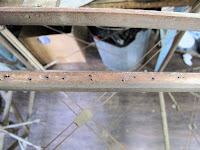At the last station in the fuselage there is a piece of fabric laced to the tubes with flat brown shoe laces. The only purpose I can figure out for it is to act as an Air Dam blocking flow through the opening for the tail skid. The whole bottom of the fuselage aft of this station is open so I can believe there was exhaust coming back into the cockpit through that opening from positive pressure below the fuselage and negative pressure at the cockpit opening.
It's not a later addition because you can see it in the covered fuselage from this factory photo, June 26, 1926, within days of my plane leaving the factory. Some day I'll get my hands on the original of this photo and do a higher resolution scan. Even at this resolution, you can see that the view of top stringer on the right side of the fuselage is blocked by the air dam.
If we ever get a high resolution scan of this photo I may be able to identify the fuselage in the lower left corner. It's written in pencil on the aft side of the former where the fellow is working. Aero archeology is so much fun.
Here's what's left of the original air dam. I don't imagine it would have been replaced when the plane was recovered, so I'm sure this is a factory part. I've trapped it between 2 pieces of plexiglass to hold it flat for measuring, etc. I also assume it's a factory part since it's so well made.
It appears to be made of Grade A cotton with silver dope on the forward side and the aft side bare fabric. It may also be made from some surplus balloon or dirigible fabric, which seems more likely than them doping one side of some fabric to make these. The dirigible Shenandoah crashed Sept. 3, 1925 and the WACO factory made money hopping sightseeing rides over it. The debris was all looted. How cool if this were a piece of fabric from the Shenandoah, OK back to reality.
It's about 10" wide x 15" tall with about 3/4" folded forward along the edges and sewn down before the brass grommets were added. The 1 3/4" corner notches are for the brace wire tubes in the corners, a la Fokker D-VII. The fabric was trapped between the double wires which loop around the corner tubes. The 2" x 1 3/8" notches, 7 1/2" up the sides, are where the rudder cables pass through. More on then below.
I have plenty of Grade A cotton but it's already 30 years old. I'll probably make this using Poly Fiber.
You can see in the pictures above a small piece of the shoe lacing used to attach the dam to the tubes. The shoe lace seems to have protected the paint below it enough that you can see the candy cane stripes protected by them as they wrapped around the tubes.
I assume this air dam was needed because they went to a lot of trouble to make and install it.
Where the brace wire cross in the center of the bay there is a small roll of rubberized Friction Tape to prevent the wire and turnbuckle from rubbing. They used friction tape a lot at WACO.
The rudder cables exit the fuselage aft of this bay. To protect the cables from chafing on the tubing there is a piece of 1/8" thick leather about 2" wide laced to the vertical tubes.
You can see where the cable rubbed during about 1,100 hours of flying.
It's laced on with what looks to be cotton rib stitching cord, another thing they used a lot, think cheap like zip ties today. The stringers on the sides of the fuselage were laced on with it. A topic for another post.
I plan to make up CAD drawings for all this as I make up the new parts.































